I am making this thread from information found elsewhere in the forum and some YouTube videos. I did not create or perform any of these items. Because of the research I had to do to answer someone else's question, I figured why not put it where all will find it.
From a post by @MyShibbyEco in Engine oil cooler replacement? (videos to follow):
Here are the steps in my service manual for a 1.4L LUH or LUJ engine.
REMOVAL
1) Disconnect battery negative cable. Refer to Battery Negative Cable Disconnection and Connection .
2) Drain engine coolant. Refer to Cooling System Draining and Filling
3) Remove the turbocharger oil feed pipe. Refer to Turbocharger Oil Feed Pipe Replacement .
4) Remove the warm up three way catalytic converter. Refer to Warm Up Three-Way Catalytic Converter Replacement .
5) Lower vehicle.
6) Remove the air cleaner outlet duct. Refer to Air Cleaner Outlet Duct Replacement .
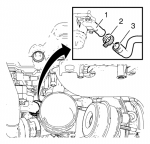
7) Remove the oil cooler outlet hose clamp (2).
8) Remove the oil cooler outlet hose (3) from the thermostat housing (1).
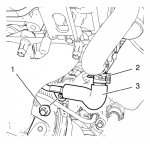
9) Remove the turbocharger coolant return pipe bolt (1) from the oil cooler housing.
10) Remove the turbocharger coolant return pipe clamp (2).
Note: Do not move the turbocharger coolant return pipe too much. An excessive moving of the turbocharger coolant return pipe could cause leakage.
11) Remove the turbocharger coolant return pipe (3) from the oil cooler inlet pipe.
12) Disconnect the oil pressure indicator switch wiring harness plug.
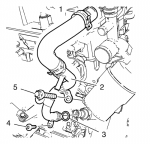
13) Remove the oil cooler inlet hose clamp (1) and remove the oil cooler inlet hose from the water outlet.
14) Remove the engine oil cooler bolt (5).
15) Remove the engine oil cooler inlet pipe bolt (4).
16) Remove the engine oil cooler inlet pipe (2) and the seal ring (3).
17) Raise vehicle.
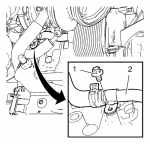
18) Remove the oil cooler outlet pipe bolt (1) from the engine block.
19) Remove the oil cooler outlet pipe (2) in compound with the oil cooler outlet hose.
20) Lower vehicle.
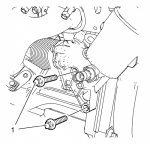
21) Remove the 2 oil cooler bolts (1).
22) Raise vehicle.
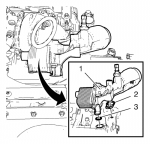
23) Remove the oil cooler (1) in compound with the oil cooler gasket (2) and the seal ring (3).
24) Remove the oil pressure indicator switch from the oil cooler.
INSTALLATION
1) Install the oil pressure indicator switch to the oil cooler. Use a NEW seal ring.
Caution: Refer to Fastener Caution in the Preface section.
2) Tighten the oil pressure indicator switch to 20 N·m (15 lb ft).

3) Clean the sealing surfaces.
4) Install the oil cooler (1) in compound with a NEW oil cooler gasket (2) and a NEW seal ring (3).
5) Lower vehicle.

6) Install the 2 oil cooler bolts (1) and hand tighten.

7) Install the engine oil cooler inlet pipe (2) in compound with a NEW seal ring (3).
8) Install the oil cooler inlet hose to the water outlet and install the oil cooler inlet hose clamp (1).
9) Install the engine oil cooler bolt (5).
10) Install the engine oil cooler inlet pipe bolt (4) and tighten to 10 N·m (89 lb in).
11) Tighten the 3 engine oil cooler bolts to 20 N·m (15 lb ft).

12) Install the turbocharger coolant return pipe (3) to the oil cooler inlet pipe.
13) Install the turbocharger coolant return pipe clamp (2).
14) Install turbocharger coolant return pipe bolt (1) and tighten to 10 N·m (89 lb in).
15) Connect the oil pressure indicator switch wiring harness plug.
16) Raise vehicle.


17) Install the oil cooler outlet pipe (2) in compound with the oil cooler outlet hose to the oil cooler.
18) Install the oil cooler outlet pipe bolt (1) to the engine block and tighten to 10 N·m (89 lb in).
19) Install the warm up three way catalytic converter. Refer to Warm Up Three-Way Catalytic Converter Replacement .
20) Install the oil cooler outlet hose (3) to the thermostat housing (1).
21) Install the oil cooler outlet hose clamp (2).
22) Install the air cleaner outlet duct. Refer to Air Cleaner Outlet Duct Replacement .
23) Install the turbocharger oil feed pipe and the exhaust manifold heat shield. Refer to Turbocharger Oil Feed Pipe Replacement .
24) Connect battery negative cable. Refer to Battery Negative Cable Disconnection and Connection .
25) Fill engine coolant. Refer to Cooling System Draining and Filling .
From a post by @MyShibbyEco in Engine oil cooler replacement? (videos to follow):
Here are the steps in my service manual for a 1.4L LUH or LUJ engine.
REMOVAL
1) Disconnect battery negative cable. Refer to Battery Negative Cable Disconnection and Connection .
2) Drain engine coolant. Refer to Cooling System Draining and Filling
3) Remove the turbocharger oil feed pipe. Refer to Turbocharger Oil Feed Pipe Replacement .
4) Remove the warm up three way catalytic converter. Refer to Warm Up Three-Way Catalytic Converter Replacement .
5) Lower vehicle.
6) Remove the air cleaner outlet duct. Refer to Air Cleaner Outlet Duct Replacement .

7) Remove the oil cooler outlet hose clamp (2).
8) Remove the oil cooler outlet hose (3) from the thermostat housing (1).

9) Remove the turbocharger coolant return pipe bolt (1) from the oil cooler housing.
10) Remove the turbocharger coolant return pipe clamp (2).
Note: Do not move the turbocharger coolant return pipe too much. An excessive moving of the turbocharger coolant return pipe could cause leakage.
11) Remove the turbocharger coolant return pipe (3) from the oil cooler inlet pipe.
12) Disconnect the oil pressure indicator switch wiring harness plug.

13) Remove the oil cooler inlet hose clamp (1) and remove the oil cooler inlet hose from the water outlet.
14) Remove the engine oil cooler bolt (5).
15) Remove the engine oil cooler inlet pipe bolt (4).
16) Remove the engine oil cooler inlet pipe (2) and the seal ring (3).
17) Raise vehicle.

18) Remove the oil cooler outlet pipe bolt (1) from the engine block.
19) Remove the oil cooler outlet pipe (2) in compound with the oil cooler outlet hose.
20) Lower vehicle.

21) Remove the 2 oil cooler bolts (1).
22) Raise vehicle.

23) Remove the oil cooler (1) in compound with the oil cooler gasket (2) and the seal ring (3).
24) Remove the oil pressure indicator switch from the oil cooler.
INSTALLATION
1) Install the oil pressure indicator switch to the oil cooler. Use a NEW seal ring.
Caution: Refer to Fastener Caution in the Preface section.
2) Tighten the oil pressure indicator switch to 20 N·m (15 lb ft).

3) Clean the sealing surfaces.
4) Install the oil cooler (1) in compound with a NEW oil cooler gasket (2) and a NEW seal ring (3).
5) Lower vehicle.

6) Install the 2 oil cooler bolts (1) and hand tighten.

7) Install the engine oil cooler inlet pipe (2) in compound with a NEW seal ring (3).
8) Install the oil cooler inlet hose to the water outlet and install the oil cooler inlet hose clamp (1).
9) Install the engine oil cooler bolt (5).
10) Install the engine oil cooler inlet pipe bolt (4) and tighten to 10 N·m (89 lb in).
11) Tighten the 3 engine oil cooler bolts to 20 N·m (15 lb ft).

12) Install the turbocharger coolant return pipe (3) to the oil cooler inlet pipe.
13) Install the turbocharger coolant return pipe clamp (2).
14) Install turbocharger coolant return pipe bolt (1) and tighten to 10 N·m (89 lb in).
15) Connect the oil pressure indicator switch wiring harness plug.
16) Raise vehicle.


17) Install the oil cooler outlet pipe (2) in compound with the oil cooler outlet hose to the oil cooler.
18) Install the oil cooler outlet pipe bolt (1) to the engine block and tighten to 10 N·m (89 lb in).
19) Install the warm up three way catalytic converter. Refer to Warm Up Three-Way Catalytic Converter Replacement .
20) Install the oil cooler outlet hose (3) to the thermostat housing (1).
21) Install the oil cooler outlet hose clamp (2).
22) Install the air cleaner outlet duct. Refer to Air Cleaner Outlet Duct Replacement .
23) Install the turbocharger oil feed pipe and the exhaust manifold heat shield. Refer to Turbocharger Oil Feed Pipe Replacement .
24) Connect battery negative cable. Refer to Battery Negative Cable Disconnection and Connection .
25) Fill engine coolant. Refer to Cooling System Draining and Filling .





